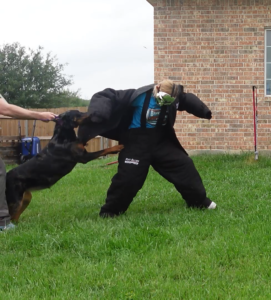Personal Protection Dog Training
What is personal protection dog training?
There is no clear definition for that, we must break down that phase and define each word for a better understanding. Personal as defined by the Oxford dictionary: Of, relating to, concerning, or affecting a person as a private individual (rather than as a member of a group or the public, or in a public or professional capacity); individual, private; one’s own.
Protection as defined by Dictionary.com: the act of protecting or the state of being protected; preservation from injury or harm.
With this information, one can see that personal protection is the act of having a dog trained to prevent harm to a private person.
For this article, I will take it one step further and say personal protection dog is one that can show real aggression on demand. Meaning, that the dog has been trained to bark, air snap, and or bite on given a command to do so in a variety of scenarios including with and without a muzzle. At Species K9 we refer to personal protection dogs as controlled aggression.
How do we train personal protection dogs?
First and foremost, we do not start any personal protection training until the dog has completed all 3 phases of training and the owner has complete verbal control of the dog. Second, the dog must be at least 2 years of age. Once those prerequisites are met, we start to build upon the dog’s instinct to protect its family members and slowly teach the dog its bark has meaning, followed by its actions have meaning, and lastly it learns its bite has meaning. This is true protection training, we are working in defense, fight and prey drives, not play drive as you see in sport work, such as IPO, French Ring, or Schutzhund. These dogs are working in play drive if the situation changes from the pattern training the dog is used to, the dog will not know what to do. If the decoy were to break from the blind and run at the dog, would the dog hold its ground (defense drive), attack and bite the decoy (fight drive), or just run away (flight drive) self-preservation? Unfortunately, on the sporting field, we will never know.
Who should own a personal protection trained dog?
When an owner makes that choice to begin training their dog to bite on command and have controlled aggression you take on a lot of liability. The owner needs to be able to put in the time to train and maintain the training. Ensuring you have secure fences, locked gates, and continued training with the basics in 3rd phase. When done right you can have an amazing level of security and protection for yourself and your family. Walking down the street with a dog you know without hesitation will bite and show real aggression to someone attempting to cause you harm is very comforting.
On the flip side, having a dog that is not under control, that will bite and show aggression without warning is a liability. Not having verbal control over your dog in a real-world situation is a recipe for a lawsuit and possible criminal action. Someone comes up to you on the street, grabs you, and starts to pull you toward an open car door. This is a serious situation, you drop your leash give the command, and your dog goes into full attack; you break free and start to run down the street. You turn back and see that the attacker managed to break free from the dog and is now running away from you and your dog. The treat is over. End of story. You try to recall your dog, and your dog does not respond. You watch in horror as your dog switches from fight drive into prey drive and is now chasing said dirtbag down the street. You are now the attacker and can be held liable for any damages that happen next. This is why you must have full verbal control over your dog prior to switching that aggression switch in your dog’s brain. It’s for your protection as well as your dog. In the above situation, your dog could be taken from you and put down.
When you consider owning a personal protection dog be sure to ask lots of questions and under what you are getting. If you have any question please feel free to reach out to us.

